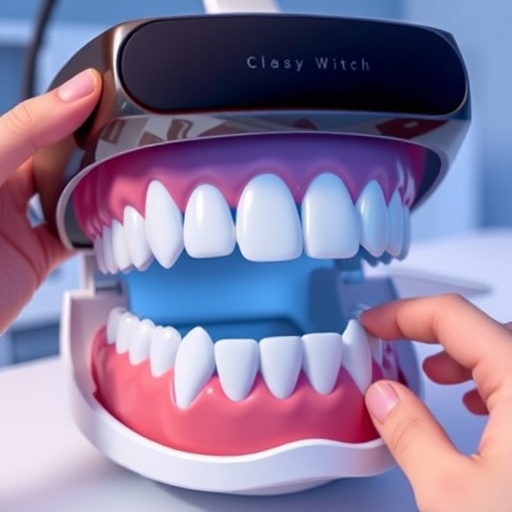Virtual reality (VR) is poised to revolutionize preclinical dental education, providing innovative tools for the preparation of inlays, which are integral to restorative dentistry. As the healthcare field continues to embrace technology, a recent study by Sun et al. highlights the efficacy of a VR-based digital platform designed specifically for enhancing the learning experience among dental students. This platform not only mirrors real-life scenarios but also allows learners to hone their skills in a risk-free environment, thus addressing some of the complexities and challenges encountered in traditional dental education.
The study, published in BMC Medical Education, documents the development and deployment of this VR platform aimed at inlay tooth preparation. It meticulously outlines how this pioneering technology integrates multiple educational facets, ensuring that students gain not just technical knowledge but also practical skills that are crucial for their future professional endeavors. With VR, students can manipulate virtual dental tools, visualize the anatomy of the tooth, and understand the implications of each movement and decision they make in a simulated setting.
Furthermore, the study presents comparative analyses between traditional teaching methods and the immersive experiences offered by VR. Traditional dental education often relies heavily on the use of models and simulation on patients, which can sometimes be limiting. In contrast, the VR platform enables students to repeat procedures without the constraints posed by raw materials or time. Imagine a classroom where students can spend hours perfecting their technique without the fear of wasting resources or making irreversible mistakes – this is the transformative promise of VR.
The platform not only fosters skill acquisition but also promotes a deeper understanding of the procedural steps involved in inlay preparation. Through gamification elements incorporated into the VR experience, students are engaged in a manner that is both educational and enjoyable. This dual approach enhances retention of knowledge and skills, as learners are more likely to remember experiences that they found stimulating and rewarding. This paradigm shift in learning encourages not just passive absorption of information but also active participation in the educational process.
In addition to its pedagogical benefits, the study indicates that the VR platform may also play a significant role in assessment and competency evaluation. In traditional settings, educators often face challenges in measuring the skill levels of students accurately. However, the VR platform allows for quantitative and qualitative assessments, capturing detailed metrics of student performance. This affords educators more precise insights into individual progress and skill mastery, making it easier to tailor educational approaches to the needs of each student.
Moreover, the incorporation of VR into dental curricula could lead to a significant reduction in educational costs over time. By minimizing dependence on physical models and materials, institutions may find that they can allocate resources more effectively. This potential for cost reduction, paired with the improved learning outcomes, positions the VR platform as a sustainable option in the future of dental education.
Importantly, as the study suggests, the use of VR in dental education aligns with the broader trends in medical training. The integration of simulation technology across various healthcare fields illustrates a commitment to improving patient safety and care. By better preparing future dentists through enhanced educational methodologies, the field is taking steps toward ensuring that practitioners are not only competent but also confident in their abilities to deliver high-quality care.
The results from this research will likely spark further interest and investment in VR technologies within educational institutions worldwide. As the technology becomes more accessible and refined, we may see a ripple effect as other disciplines within healthcare adopt similar platforms for training future professionals. The implications are vast; improved training methodologies could ultimately lead to better healthcare outcomes for patients.
However, the challenge lies in ensuring that all students have equal access to this advanced technology. Issues related to the cost of VR equipment and the need for adequate technical support remain critical barriers that must be addressed. Educational stakeholders must work collaboratively to ensure that VR tools are integrated across diverse learning environments, particularly in under-resourced areas.
In conclusion, the study conducted by Sun et al. paves the way for a revolution in dental education. The enhanced engagement, skills mastery, and potential cost benefits of a VR-based learning platform signify an important leap forward. As the field moves towards embracing these technological advancements, the future of dental education is set to be more dynamic, effective, and inclusive, redefining how aspiring dentists learn and prepare for their careers.
The research illustrates that VR in dental education is not just a passing trend; it is a genuine evolution that could reshape the landscape of training future dental practitioners. By harnessing the power of immersive technology, we can foster a new generation of healthcare professionals equipped with the skills, confidence, and competencies necessary to enhance patient care and ensure successful treatment outcomes.
Subject of Research: Enhancing preclinical dental education through VR-based digital platforms.
Article Title: Enhancing preclinical dental education through a VR-based digital platform for inlay tooth preparation.
Article References:
Sun, J., Zhang, X., Qin, Z. et al. Enhancing preclinical dental education through a VR-based digital platform for inlay tooth preparation. BMC Med Educ 25, 1630 (2025). https://doi.org/10.1186/s12909-025-08138-y
Image Credits: AI Generated
DOI: https://doi.org/10.1186/s12909-025-08138-y
Keywords: Virtual reality, dental education, preclinical training, inlay preparation, immersive technology.




